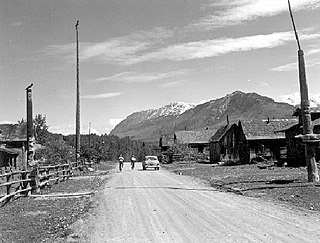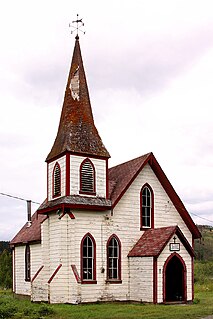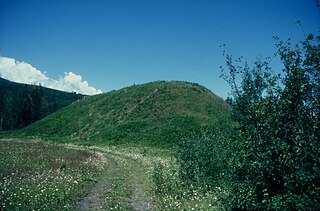Glen Vowell is an Indian reserve community of the Gitxsan people in the Hazelton area of the Skeena Country of northwestern British Columbia, Canada. It is located on the west side of the Skeena River between Hazelton and Kispiox. Its traditional name is Sik i dak, which has also been spelled Sikadoak and is reflected in the name of the reserve, Sik-e-dahk IR 2. [1] Also nearby is another Indian reserve, Anlaw Indian Reserve No. 4. [2] The band government of the reserve is the Glen Vowell Indian Band, which also goes by the name Sik-e-Dakh. [3]
In Canada, an Indian reserve is specified by the Indian Act as a "tract of land, the legal title to which is vested in Her Majesty, that has been set apart by Her Majesty for the use and benefit of a band."

Gitxsan are an indigenous people of Canada whose home territory comprises most of the area known as the Skeena Country in English. Gitksan territory encompasses approximately 53,000 square kilometres (20,000 sq mi) of land, from the basin of the upper Skeena River from about Legate Creek to the Skeena's headwaters and its surrounding tributaries. Part of the Tsimshianic language group, their culture is considered to be part of the civilization of the Pacific Northwest Coast, although their territory lies in the Interior rather than on the Coast. They were at one time also known as the Interior Tsimshian, a term which also included the Nisga'a, the Gitxsan's neighbours to the north. Their neighbours to the west are the Tsimshian while to the east the Wet'suwet'en, an Athapaskan people, with whom they have a long and deep relationship and shared political and cultural community.

Hazelton is a village located at the junction of the Bulkley and Skeena Rivers in northern British Columbia, Canada. It was founded in 1866 and has a population of 305 (2011). The nearby larger community of New Hazelton is the northernmost point of the Yellowhead Highway, a major interprovincial highway which runs from Prince Rupert, British Columbia to Portage la Prairie, Manitoba.
The site was first identified on official maps in BC Mines Department records from 1910 as ""Glenvowell Salvation Army Mission". By 1922 this was adjusted to "Glen Vowell (Mission)" and as "Glen Vowell (Indian Village & Mission)" in the 1930 BC Gazetteer. [4]
The name is derived from that of Arthur Stewart Vowell, who surveyed the townsite in 1898 during the eponymous Vowell Commission, one of a series of Royal Commissions concerned with allocating Indian Reserves across British Columbia.
Coordinates: 55°18′44″N127°40′24″W / 55.31222°N 127.67333°W

A geographic coordinate system is a coordinate system that enables every location on Earth to be specified by a set of numbers, letters or symbols. The coordinates are often chosen such that one of the numbers represents a vertical position and two or three of the numbers represent a horizontal position; alternatively, a geographic position may be expressed in a combined three-dimensional Cartesian vector. A common choice of coordinates is latitude, longitude and elevation. To specify a location on a plane requires a map projection.









